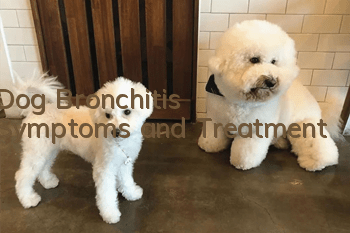Dog Bronchitis Symptoms and Treatment

Bronchitis refers to chronic non-specific inflammation of the trachea, bronchial mucosa and surrounding tissues. The main cause of bronchitis is chronic non-specific inflammation of the bronchial tubes caused by repeated viral and bacterial infections. Falling temperature, spasm and ischemia of small blood vessels in the respiratory tract, and decreased defense function are conducive to the onset of the disease; chronic stimuli such as smoke, dust, and polluted air can also cause the disease. Canine bronchopneumonia refers to inflammation of individual lobules or several pulmonary lobules, so it is also called canine lobular pneumonia. Dog bronchopneumonia is not difficult to treat. As long as you pay attention to daily care and use correct medication, the general cure rate can reach more than 95%.
1. Symptoms of bronchitis in dogs
The main clinical features are flaccid fever, increased breathing frequency, cough, and localized pneumonia lesions in the lungs. Canine bronchopneumonia is an inflammation of the bronchi, bronchioles and pulmonary lobules caused by colds, physical and chemical factors, and certain infectious and parasitic diseases. The alveoli are usually filled with catarrhal exudate composed of epithelial cells, plasma and white blood cells, so it is also called catarrhal pneumonia. It is characterized by scattered areas of focal dullness on percussion and crepitus on auscultation. Puppies and older dogs are more susceptible, with the highest incidence rates in late autumn, winter and early spring.
Laboratory examination showed that the symptoms were similar to those of canine distemper and canine parainfluenza in the early and middle stages. CDV and CPIV colloidal gold rapid tests were performed, and the results were negative. Routine blood examination revealed that the total number of white blood cells and neutrophils increased, and the nucleus shifted to the left. X-ray examination revealed that the lung markings were aggravated and there were small patchy shadows.
2. Treatment of bronchopneumonia in dogs
Canine bronchopneumonia is easily confused with canine colds, panbronchitis, canine distemper, and canine lobar pneumonia. Therefore, before treating canine bronchopneumonia, a diagnosis should be made first, and then appropriate treatment can be prescribed. So how should canine bronchopneumonia be treated?
The treatment principles are to strengthen nursing, improve nutrition, antibacterial and anti-inflammatory, antitussive and expectorant, stop exudation and promote exudate absorption, and symptomatic treatment. One is antibacterial and anti-inflammatory. Subcutaneous injection: ① 0.9% normal saline + 7 mL of levofloxacin injection; ② Pulmonary rod dual antibody + ribavirin 25 mg; ③ Dexamethasone sodium phosphate 1 mg, once/d, for 3 days. The second is to prevent leakage. Intravenous injection: 20 mL of 10% glucose + 2 mL of 10% calcium gluconate, once a day for 3 days. The third is antitussive and expectorant. Oral administration: 1 mL of compound licorice mixture, 3 times/d. The fourth is symptomatic treatment. To reduce fever, intramuscular injection of 0.5 mL of Analgesic, or oral administration of 5 mg of Nimesulide, is not required if the body temperature does not exceed 39.5°C. The fifth is to strengthen care. Reduce the exercise of sick dogs, feed dog food, eat small meals frequently, supplement powerful multi-dimensional nutritional cream, immune polysaccharide cream, etc. to improve the body's immunity and promote recovery.
3. Dog bronchusPrecautions for pneumonia
The treatment of canine bronchopneumonia is not very difficult. It is mainly inflammation of the bronchi or bronchioles and pulmonary lobules caused by colds, physical and chemical factors, and certain infectious diseases and parasites. However, in the treatment and care of canine bronchopneumonia, During the process, there are still six things to pay attention to.
1. Early diagnosis is the key to treating canine bronchopneumonia. If it is not diagnosed and treated in time, it can lead to aggravation of the condition and death in severe cases. Controlling and eliminating inflammation is the fundamental measure in the treatment of lobular pneumonia, and it must be carried out throughout the entire treatment process. The selection of antimicrobial drugs is the key to treating canine pulmonary infections. The pathogen cannot be identified in most cases, so when selecting antibiotics, both cocci and bacilli should be taken into consideration, and comprehensive considerations should be taken to establish effective empirical therapy. If possible, a drug sensitivity test can be done to select sensitive antibiotics.
2. According to clinical observation, in the case of severe inflammation, animals may often enter a state of shock. A large number of treatment practices have proven that shock is the main cause of death in canine bronchitis cases. When dyspnea occurs or hypoxemia is suspected, oxygen should be inhaled as soon as possible (oxygen concentration is 30%) if possible. If mouth breathing continues and the ribs are inflamed, the prognosis is generally poor.
3. Symptomatic treatment. For high fever, you can take Diazepam or Nimesulide; for severe chest pain, you can take codeine syrup orally; for cough, you can take codeine or Kebiqing; for phlegm, you can take Runjin, mucosolvan, ammonium chloride mixture, acetate Cysteine or chymotrypsin, etc.; to maintain water and electrolyte balance, oral rehydration salts or infusion can be used (control the infusion speed and total amount of fluid); aerosol treatment (early use), the formula is antibiotics, chymotrypsin, glucocorticoids, etc. , add normal saline to 10-100mL; for sedative cough, licorice, cough syrup, etc. can be used; early use of glucocorticoids can prevent and treat cardiac and renal insufficiency and respiratory failure.
4. After the symptoms stabilize, the lung respiratory function will weaken, and there is still the possibility of recurrence in the short term. No strenuous exercise is allowed and please keep warm.
5. The sick dog should be re-examined, and another chest fluoroscopy can be performed at a certain interval to monitor the recovery of the lungs and determine whether complications may occur.
6. The kennel and environment should be disinfected regularly. Disinfection is a key measure to cut off the spread of respiratory infectious diseases. It has the advantages of being simple, easy to implement, saving time and effort, and is as important as immunization.
- Can dogs get tooth decay?
- How much does a Shih Tzu cost and is it easy to keep?
- Can dogs eat watermelon in summer?
- What is canine parainfluenza? Symptoms and treatment of canine parainfluenza
- How to train and correct little Springer’s bad behavior
- What to do if your dog has urinary incontinence
- How to tell the age of a Border Collie from its teeth?
- How to get rid of the strong dog smell at home
- Is Pug a picky eater if he doesn’t eat dog food well? Pug dogs are picky and don’t eat dog food!
- There are several foods that are not good for your dog’s health, not even one bite!



